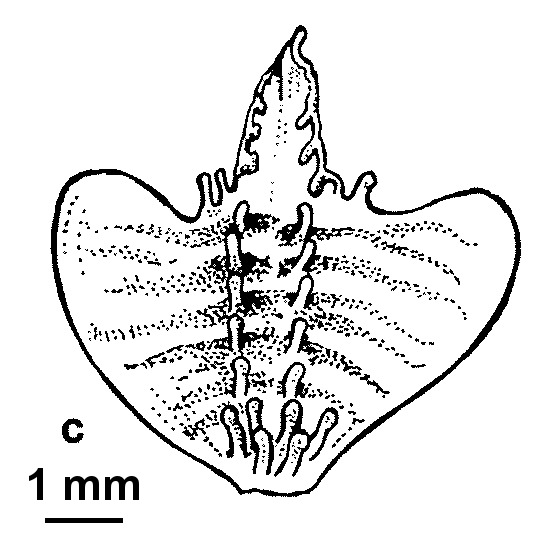Caladenia prolata
D.L.JonesFlowering plant slender, 12–24 cm tall. Leaf linear, usually equal to the flowering stem, 3–5 mm wide. Flowers 1 or 2, dull greenish white inside, externally greenish from dense glands and a dark red central stripe; ovary usually 10–14 mm long, often swollen at flowering time; perianth segments 10–14 mm long, glandular outside, with acute to acuminate tips; dorsal sepal erect, incurved, slightly hooded, linear-oblanceolate, 2.5–3.5 mm wide; lateral sepals directed outward and forward, asymmetrically linear-lanceolate, 3–3.5 mm wide; petals spreading, asymmetrically lanceolate, 3–3.5 mm wide. Labellum on short claw, 3-lobed, 5–6 mm long (when flattened), dull pink with narrow red transverse bars; lateral lobes prominent, broad, margins entire except for 2 or 3 pairs of calli near base of mid-lobe; mid-lobe small, directed outward and forward or slightly recurved in distal half, triangular, about as long (when straightened) as lateral lobes, margins with 3–6 pairs of calli, tip of labellum yellow, irregularly crenulate and undulate; lamina calli in 2 rows extending almost to the base of the mid-lobe, stalked and clubbed, basal calli pair yellow, the rest white. Column recurved at base, strongly incurved above, narrowly winged, greenish, barred dark-red; anther with prominent short point. Flowers Oct.–Nov.
Wim, GleP, VVP, CVU, DunT, HSF, OtR. Also SA (south-eastern corner), Tas. Recorded from near Portland, Casterton, Edenhope, Upper Beaconsfield and in Brisbane Ranges, but probably overlooked or mis-identified elsewhere. Grows in coastal scrub and heathy forest on well-drained sandy loams.
Caladenia prolata is similar to C. vulgaris, but is heavily glandular, has broader stems and leaves, and dull white flowers with ovaries usually 10–14 mm long and swollen. In addition, in C. prolata, the lateral lobes of the labellum have a few marginal calli near the mid-lobe, while those of C. vulgaris are completely entire. Late flowering plants from the Brisbane Ranges differ from C. prolata in having a thinner leaf, and shorter ovaries (c. 7 mm long) which are hardly swollen.
Entwisle, T.J. (1994). Orchidaceae. In: Walsh, N.G.; Entwisle, T.J., Flora of Victoria Vol. 2, Ferns and Allied Plants, Conifers and Monocotyledons, pp. 740–901. Inkata Press, Melbourne.
 Spinning
Spinning

